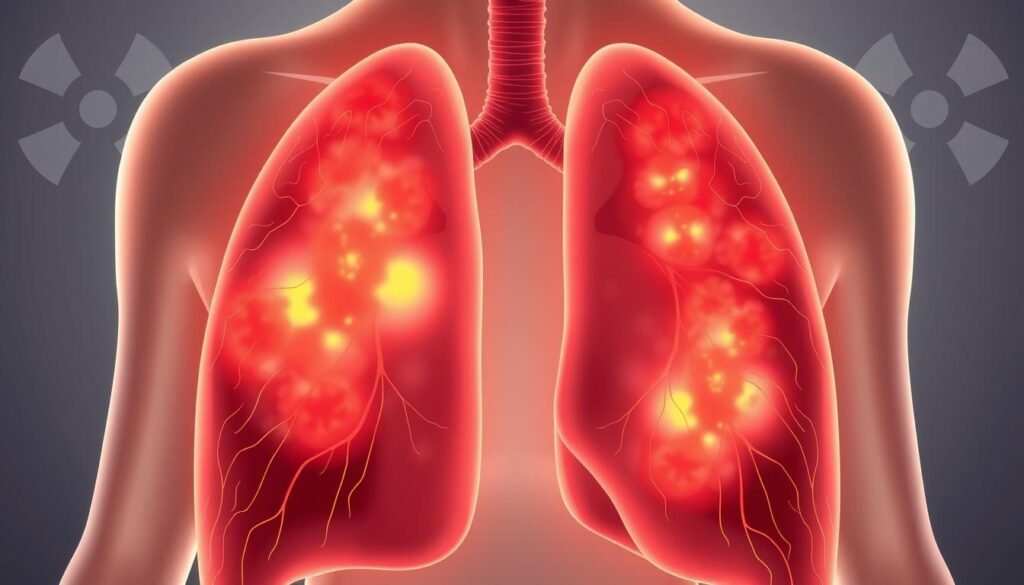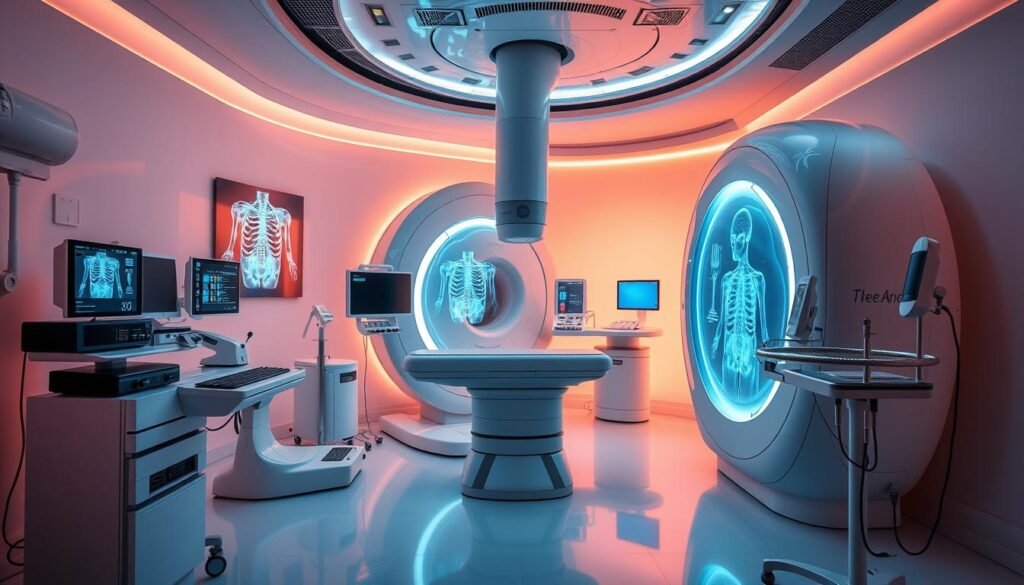Did you know radiation therapy for breast cancer can raise the risk of heart issues? Studies show that getting over 60 Gy to the left breast can triple the risk of heart disease. This info is vital as more women survive breast cancer and live longer.
Radiation therapy is often used to treat breast cancer. It can lead to long-term health problems, aside from the initial treatment. Even though many see great results in how they look, with 70-87% happy with their breast conservation therapy, the long-term risks like heart disease, lung problems, and even other cancers need attention.
It’s important for survivors to keep an eye on the effects of radiation on their health over time. Knowing about these risks can help manage them better. This knowledge can improve how survivors live after treatment.
Key Takeaways
- Long-term effects of radiation therapy can include cardiovascular health risks.
- Survivors should monitor for symptoms of lung complications years after treatment.
- Awareness of secondary cancer risks is essential for ongoing health management.
- Exercise may help mitigate some of the fatigue and symptoms post-treatment.
- Regular follow-up care plays a critical role in the health of breast cancer survivors.
Introduction to Radiation Therapy for Breast Cancer
Radiation therapy is key for treating breast cancer, especially after surgery like lumpectomy or mastectomy. This introduction shows how it targets and destroys remaining cancer cells in the breast.
External radiation is the main type used for breast cancer. It involves a machine sending radiation to the breast from outside. It’s often done after a lumpectomy to lower the risk of cancer coming back. It starts between six and twelve weeks after surgery.
After a mastectomy, doctors may suggest radiation if the cancer has spread to lymph nodes, the tumor is bigger than two inches, or cancer cells are found in the edges of the removed tissue. This highlights the importance of understanding radiation’s effects for long-term health.
Planning radiation therapy requires a team effort. Experts like radiation oncologists, therapists, and medical physicists work together to ensure precision. Patients usually undergo treatment five days a week, for five to six weeks. Shorter, intense schedules are becoming more common to reduce side effects.
Side effects can include fatigue, skin irritation, and swelling of the breast. Symptoms range from redness and itching to discomfort. To help, patients should follow care tips like using certain lotions and staying out of the sun.
Radiation therapy is crucial in breast cancer care. Understanding how it works helps patients choose the best treatment options for them.
Understanding Radiation Toxicity
Radiation toxicity is key in treating breast cancer with radiation therapy. This treatment targets cancer cells but can harm normal tissues too. Side effects like fatigue and skin changes are common but usually go away a few months after treatment.
Later, months or years post-treatment, other effects can show up. Factors like the treatment area and the radiation dose matter. Issues can include chronic skin problems, lymphedema, and sometimes, cognitive issues. Skin might turn red, swell, and become more sensitive to sunlight, affecting daily life.
Common long-term symptoms of radiation toxicity include:
- Fatigue that can last a long time after treatment
- Changes in how the skin looks and feels
- Lymphedema, due to blocked lymph flow
- Tissue fibrosis, affecting how flexible and functional the area is
Ongoing education and check-ups help manage radiation side effects. Patients worry about late side effects, so it’s vital to talk openly with doctors. Understanding the risks and managing recovery is easier with this open dialogue. For more on managing radiation effects, NCBI publications offer detailed information and strategies tailored to each patient.
Long-Term Risks of Radiation Therapy for Breast Cancer
It’s crucial to understand the long-term risks of radiation therapy. This knowledge helps breast cancer survivors grasp what they may face. The risks impact their physical and emotional health. There are ways to manage these issues, even though emotional effects might last a long time.
Impact on Quality of Life for Survivors
The life quality of breast cancer survivors can change because of past treatments like radiation. They might feel very tired, emotionally upset, and physically weak. It’s important to look after their mental health, how they function day-to-day, and even their sex life.
Support and new research can make a big difference. There are clinical trials working on better care and help for survivors.
Correlation with Other Health Issues
After radiation therapy, there’s a higher chance of getting heart or lung diseases. Patients might get lymphedema, heart problems, or even leukemia. Staying on top of health with regular checks is key.
| Health Issue | Possible Causes | Management Strategies |
|---|---|---|
| Cardiac Problems | Radiation treatment to the chest area | Regular check-ups and heart health monitoring |
| Lung Complications | Radiation therapy | Lung function tests and smoking cessation programs |
| Bone Health Issues | Radiation effects | Regular bone density screenings and lifestyle modifications |
| Lymphedema | Surgery or radiation impacting lymphatic drainage | Physical therapy and compression garments |
| Psycho-Social Effects | Emotional distress from treatment | Counseling and support groups |
Common Side Effects of Radiotherapy
Radiotherapy is key in treating breast cancer. Yet, it comes with side effects for many. Fatigue, skin changes, and hair loss at the treatment spot are common early on. These usually go away in a few months.
Over time, some patients see long-term effects. These can include darker skin, bigger pores, fluid build-up, and breast size changes from scarring. Sometimes, a condition called lymphedema or pain in the treated area may occur.
- Fatigue, often the most reported side effect.
- Skin reactions, including reddening and itchiness, commonly referred to as radiation dermatitis.
- Hair loss, particularly focused around the treatment site.
- Possible decreased blood cell counts affecting overall health.
Some severe side effects like brachial plexopathy, rib fractures, or lung issues are less common. Knowing about them helps patients talk to their doctors early. This way, they can manage any problems quickly.
The American Cancer Society highlights the need to report side effects. Talking openly with healthcare providers helps make treatments more tolerable.
Cardiovascular Disease as a Long-Term Risk
Radiation therapy is key in treating breast cancer. However, it poses heart health risks over time. Studies show a clear link between radiation damage and higher heart disease rates. Particularly, women getting radiation on the left side face greater heart risks than those treated on the right.
Mechanisms of Cardiac Damage
It’s crucial to understand how radiation affects the heart. The risk of heart disease increases with the total radiation dose. This can make blood vessels stiff and harm the coronary arteries. Women getting left-sided radiation between 1985 and 2008 had more than double the coronary artery disease risk compared to right-sided treatments. Their disease rate was 10.5% versus 5.8%.
Preventive Measures for Patients
With the known heart risks from radiation, preventive actions are important. Heart health monitoring is vital, especially for young breast cancer survivors. A healthy diet, regular exercise, and stress management help protect the heart.
Working together, oncologists and cardiologists can offer full support. Acting early against these risks improves life quality post-treatment. More details on radiation therapy implications are here. For info on long-term side effects, click here.
- Engage in heart-healthy exercises.
- Monitor blood pressure and cholesterol levels regularly.
- Discuss medication management with healthcare providers.
Lung Complications Following Treatment
People getting radiation therapy for breast cancer can face lung problems. These can show up as chronic cough, tiredness, and breathing troubles. It’s very important for both doctors and patients to know about these symptoms. Because the risk of lung issues may go up with certain radiation treatments.
Identifying Symptoms and Risks
Knowing what to watch for with lung issues is key for looking after patients. The common signs of lung trouble are:
- Chronic cough
- Fatigue
- Shortness of breath
- Chest discomfort
About 2.4% of women with breast cancer get lung injuries from radiation. These injuries have different levels of severity. But, most cases are considered Grade II. Main risk factors for lung injuries include past lung problems and a lot of radiation exposure.
Long-Term Monitoring Strategies
Watching patients over the long term is very important after radiation therapy. Regular checks help catch any lung problems early. Doctors suggest:
- Routine pulmonary function tests
- Imaging studies to check the lungs
- Teaching patients about lung complication signs
Stressing these steps helps in taking early action. It keeps both doctors and patients alert about lung health. Catching issues early can help improve life quality and lessen radiation therapy risks.

Secondary Malignancies Post-Radiotherapy
Breast cancer survivors face a significant long-term health concern after radiotherapy: the risk of developing secondary cancers. Research has shown how often these secondary cancers occur. This underlines the need for survivors to keep a close watch on their health.
Statistics on Occurrence
About 17% to 19% of people who beat one cancer may develop another kind. According to the US National Cancer Institute’s SEER program, the chance of getting a second cancer has grown. It went from 9% between 1975-1979 to 19% between 2005-2009. Radiotherapy is linked to about 5% of these second cancers.
Many things can affect the chance of getting a second cancer. These include genetic factors and past cancer treatments. For instance, the Childhood Cancer Survivor Study showed a higher death rate from second cancers 25 years after the first diagnosis. This points out the long-term risks of radiotherapy.
The kind of treatment matters too. Using chemotherapy with radiation raises the chance of getting certain blood cancers. This is especially true for patients treated with specific drugs.
The way radiotherapy is done is also key. Studies show that some techniques, like VMAT, might increase second cancer risks more than others. Errors in setting up radiotherapy can raise exposure risks to surrounding tissues. This highlights the importance of accuracy in treatment.
Breast cancer survivors should be aware of their higher risk for secondary cancers. This risk can change based on personal factors, like smoking or genetics. Staying on top of health with regular check-ups is vital. For further information on how radiotherapy affects the chance of secondary malignancies in breast cancer survivors, look at this source.
Factors Influencing Long-Term Risks
Radiation therapy for breast cancer comes with long-term risks. It’s key to look closely at different factors that affect these risks. Factors specific to the patient and the treatment play important roles. With the right treatment plan, we can get better results and fewer problems.
Patient-Specific Risk Factors
Several risks tied to the patient can affect results after radiation therapy. Important points include:
- Age: Those under 50 might deal with ongoing pain and less function. People over 50 face more issues with function and swelling.
- Pre-existing Health Conditions: Patients already dealing with health problems may see these issues get worse with radiation therapy.
- Body Mass Index (BMI): A BMI over 30 raises the chances of complications like swelling.
Treatment-Specific Variables
Factors specific to the treatment also offer key insights into long-term risks. It’s crucial to think about:
- Radiation Dose: The dose during therapy varies a lot. Doses around 50 Gy usually mean higher risks.
- Treatment Technique: How the radiation is given, like treating the whole breast or just part of it, affects the outcome.
- Treatment Field Size: Bigger areas of treatment raise the risk for sensitive spots like the heart and lungs.

| Factor | Impact on Long-Term Effects |
|---|---|
| Age | Increased risk of pain and functional problems |
| Age > 50 | Functional decline and lymphedema |
| BMI > 30 | Higher incidence of lymphedema |
| Mastectomy & Lymph Node Dissection | Compromised arm function and higher morbidity |
| Radiation Therapy | May exacerbate pre-existing health conditions |
Looking at both patient-specific risks and treatment details helps manage long-term effects better. Understanding these points helps create care plans. These plans aim to improve life quality and health outcomes for patients.
Importance of Long-Term Follow-Up Care
Long-term follow-up care is vital for breast cancer survivors who finished radiation therapy. It’s key to know late side effects could start months or years later. Survivors need to be checked often for their health. This shows why regular health screenings are a must.
Care teams with many types of doctors are crucial for good survivor care. They make sure each survivor gets the right check-ups. These teams have oncologists, primary care doctors, and specialists for side effects. They do regular check-ups, look for symptoms, and run tests to watch over survivors’ health well. Tests might check blood, liver, and kidney functions.
Depending on their treatment, some survivors may need special tests. Like, those who had bleomycin or a bone marrow transplant might need checks on their lung function. And, people treated with chest radiation might need EKGs. These special care steps help find health problems early.
Survivors under 40 who got chest radiation should keep getting mammograms regularly. Keeping detailed health records helps a lot in future care. These records give doctors a full view of the survivor’s health history. They include details on treatment, side effects, and tests.
Survivors should talk openly with their care teams. They should ask about the risk of cancer coming back, symptoms to watch for, long-term side effects, and needed tests. Talking about how often to visit and support services may help too.
| Follow-Up Care Components | Purpose |
|---|---|
| Physical Exams | Assess overall health and detect early signs of complications. |
| Blood Tests | Evaluate blood counts and organ function. |
| Lung Function Tests | Identify respiratory issues in patients at risk. |
| EKGs | Monitor heart function in individuals treated with radiation to the chest. |
| Mammograms | Screen for breast cancer recurrence in young survivors. |
Long-term follow-up helps maintain health and life quality. It lowers risks from past treatments. To understand health issues better, distinguishing between chronic ailment symptoms and cancer is important. Visit understanding key signs for more information.
Recent Advances in Radiotherapy Techniques
Recent progress in treatment methods is reshaping radiotherapy for breast cancer. These advances focus on better precision and effectiveness, with an eye on patient safety. Technologies like proton and heavy ion therapy are now used. They deliver energy precisely to tumor sites. This helps in reducing damage to the healthy tissues around the tumor.
Proton therapy is especially known for its safety benefits. It reduces radiation to areas not being targeted, making treatments safer for patients. Techniques like hybrid intensity-modulated radiotherapy (IMRT) and volumetric modulated arc therapy (VMAT) increase precision. They make sure the radiation dose is distributed more accurately.
The use of the DIBH (Deep Inspiration Breath Hold) technique is reducing risks too. It protects vital organs like the heart and lungs from radiation. Studies show combining this with advanced imaging and regional nodal irradiation improves outcomes. It helps control the disease better and lowers the chance of it coming back.
The following table summarizes key benefits of recently developed radiotherapy techniques:
| Technology | Advantages | Impact on Risks |
|---|---|---|
| Proton Therapy | Targeted energy release at tumor depths | Minimized exposure of normal tissues |
| Heavy Ion Therapy | Enhanced dose deposition characteristics | Improved targeting reduces healthy tissue risks |
| Hybrid IMRT | Better uniformity in dose distribution | Lower volume of low-dose areas |
| DIBH Technique | Reduces radiation to the heart | Decreased heart-related long-term risks |
| VMAT | Optimized treatment delivery speed | Less exposure time decreases overall risks |

These advances in radiotherapy mark significant progress in cancer treatment. They improve how we care for patients and the results we achieve. As research continues, the future of breast cancer therapy looks brighter. We’re moving towards minimizing risks and making treatments more effective.
Conclusion
Radiation therapy for breast cancer comes with risks that both patients and doctors should know. There’s a higher chance of getting a second cancer after treatment, especially for women treated after menopause. It’s key for healthcare providers to watch out for heart and lung problems too.
Awareness is vital. Most breast cancer patients live for many years after their treatment. So, it’s important to look after both their immediate and future health. Working together, patients, doctors, and researchers can make treatments better. They can also find the best ways to keep an eye on patients’ health.
As new ways to do radiation therapy are being developed, knowing about the long-term risks is essential. The healthcare world must keep educating everyone involved and push for more research. This way, we can lessen the bad side effects. We can also help people who survive breast cancer have better lives.